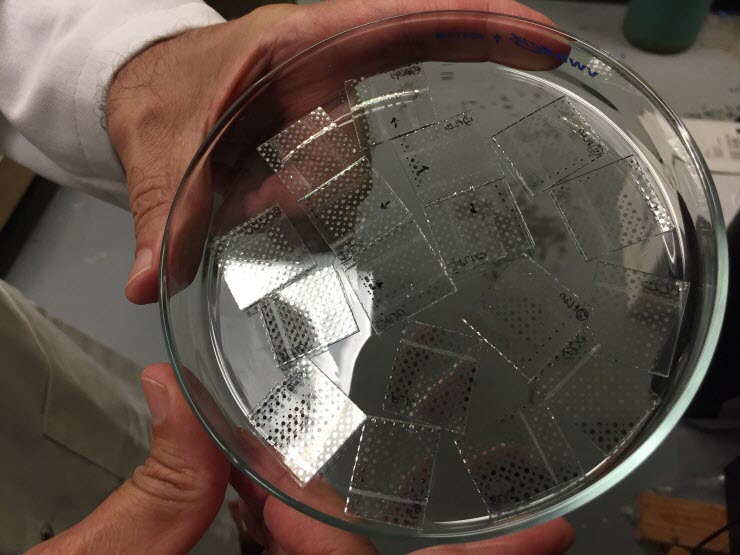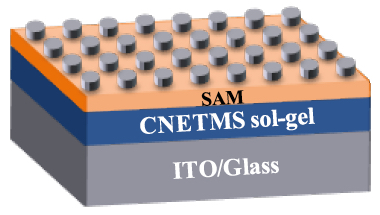New supercapacitor design offers record high-energy storage
July 31, 2015

Samples of the new hybrid sol-gel material are shown placed on a clear plastic substrate for testing (credit: John Toon, Georgia Tech)
Using a hybrid silica sol-gel material and self-assembled monolayers of a common fatty acid, Georgia Tech researchers have developed a new supercapacitor material that provides electrical-energy storage capacity rivaling some batteries.
Capacitors can provide large amounts of current quickly (high power density), unlike batteries. So if this material can be scaled up from laboratory samples, devices made from it could surpass traditional electrolytic (high-capacity) capacitors for applications in areas where quick-discharge is needed, such as electromagnetic propulsion, electric vehicles, and defibrillators. The new material also has high energy density (ability, like batteries, to store a lot of power).

Schematic representation of new thin-film capacitor using bilayer dielectric formed by self-assembled monolayer (SAM) and sol-gel and electrode layers formed by the gray discs (representing aluminum electrodes) and ITO (indium tin oxide) (not to scale). (credit: Yunsang Kim et al./ Advanced Energy Materials)
The new bilayer dielectric material is composed of a nanoscale self-assembled monolayer (SAM) (insulating) material formed between a sol-gel film and the aluminized mylar film electrodes. The bilayer structure blocks the injection of electrons into the sol-gel material, providing low leakage current, high breakdown strength, and high energy extraction efficiency.
The researchers showed that the capacitor could be rolled and re-rolled several times while maintaining high energy density, demonstrating its flexibility.
The research, supported by the Office of Naval Research and the Air Force Office of Scientific Research, was reported July 14 in the journal Advanced Energy Materials.
Better energy density than thin-film lithium ion batteries
In their structures, the researchers demonstrated maximum extractable energy densities up to 40 joules per cubic centimeter, an energy extraction efficiency of 72 percent at a field strength of 830 volts per micron, and a power density of 520 watts per cubic centimeter.
The performance exceeds that of conventional electrolytic capacitors and thin-film lithium ion batteries, although it doesn’t match the lithium ion battery formats commonly used in electronic devices and vehicles.
The next step will be to scale up the materials to see if the attractive properties transfer to larger devices. If that is successful, the researchers expect to commercialize the material through a startup company or SBIR project.
The U.S. Naval Research Laboratory was also involved in the project.
Abstract of Bilayer Structure with Ultrahigh Energy/Power Density Using Hybrid Sol–Gel Dielectric and Charge-Blocking Monolayer
A hybrid sol–gel dielectric bilayer structure yields a maximum energy density of 40 J cm−3 with high extraction efficiency. The silica sol–gel dielectric is coated by an alkylphosphonic acid monolayer, as a charge-blocking layer. The dense monolayer suppresses charge injection and electrical conduction, leading to high energy extraction efficiency, which exhibits nearly linear dielectric behavior suitable for high energy density applications.